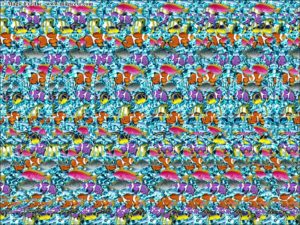Do you remember the Magic Eye images that were popular many years ago? Here’s an example. Can you see the dolphins jumping through the hoop?

Image from Magic Eye, Inc. (Look here or here for help to see it)
All Magic Eye images have a 3D image camouflaged inside a 2D graphic. The surface image may be interesting, but the truly unique image is hidden beneath the surface – but still in plain sight. The trick to seeing the 3D image is to change your visual perception. When you do see the image, it’s hard to tell someone else how it happened or how to do it, other than to give a few tips, or tell them to practice.
How we learn to see the Magic Eye image is a good metaphor for how we develop and use Tacit Knowledge.
Ritesh Chugh defines Tacit Knowledge as “skills, ideas and experiences that are possessed by people but are not codified and may not necessarily be easily expressed.” Goffin and Baxter add “With tacit knowledge, people are not often aware of the knowledge they possess or how it can be valuable to others.”
When we develop and use tacit knowledge, we often experience the result as a sudden flash of insight. This typically happens when we’re deeply immersed in data, solving a difficult problem, or trying something new. Suddenly, everything seems to make sense, much like learning to drive a car or ride a bike. You can read a lot about it and collect a lot of data, but only through deep immersion can you fully perceive the physical experience that allows it to all come together.
Recognizing and using Tacit Knowledge is crucial in business, yet it’s often overlooked. In his extremely popular Ted Talk, Simon Sinek talks about the WHAT, HOW, and WHY of a business. The essence of the business is not WHAT they do, or HOW they do it, but WHY they do it. He goes on to say that people make purchase decisions based on an unspoken shared value of WHY the business does what it does.
The problem is that most companies don’t really know WHY they are doing what they do.
This knowledge is tacit, and we can’t create it in the board room. It comes from understanding the people who buy the products, and they are often unaware of what motivates their decision-making so they can’t tell us directly. As Goffin and Baxter suggest “effective transfer of tacit knowledge generally requires extensive personal contact, regular interaction, and trust.”
Understanding WHY someone buys your products or services requires the productive use of tacit knowledge about customers as people rather than as data.
The only difference between developing and using tacit knowledge about people and seeing the Magic Eye is that we need to shift our perception of a personal, emotional experience instead of a physical experience. Only by shifting our perception (from what we feel to what they feel) can we experience that flash of insight into the real motivations for WHY they buy.
The ability to shift perception beyond the surface of the facts and data to develop a relevant body of tacit knowledge and put it to productive use is a uniquely human skill. People who have somehow mastered this skill tend to do exceptionally well in their fields. They are often described as being “unique talents,” without much thought given to how they learned to do it or whether it could be taught to others.
It’s easy to believe that this skill cannot be learned because it can’t be taught in a two-hour training workshop or a passive lecture class. To the contrary, it can be taught, but only via mentoring, immersion, and most of all, practice.
We can learn to hone our perception of personal and emotional experiences similarly to how we learn to hone our perception of physical experiences.
We live in a time where we are developing ever more powerful tools to analyze big data, and we tend to value conclusions drawn from bigger data sets as more valid regardless of how shallow the physical data may be. If we’re not careful, we run the risk of overlooking the value of incorporating the tacit knowledge hidden in the data when making important decisions.
In the next two posts, we will talk about another skill necessary to make Tacit Knowledge useful in a broad context, and then we will talk about how to apply these skills as the world of work shifts in the future.
For now, I’m interested to hear your experiences. Have you ever purposely included or excluded tacit knowledge in making a decision? Have you ever tried to teach it? What happened?
Subscribe to this newsletter if you’re interested in diving into the topic of insight and how it can help us to be more effective.

